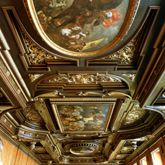Paul d. Ä.
Juvenell
painter, architectural painter, portrait painter,
born Nürnberg, 22. Dec 1579
died Preßburg, 1643
Painter of the early Baroque period. Son of Nicolaus the Elder ∞ Frankfurt/Main 31.5.1607 Anna, daughter of Christian Pfeil, brewer in Frankfurt, eight children baptized between 1608 and 1624 in Nuremberg. Apprenticeship with his father, then he is said to have continued his education with Adam Elsheimer in Rome. In 1607 he was active in Frankfurt, where he probably worked as a journeyman for Friedrich von Valckenborch. After his marriage, Juvenell returned to Nuremberg.
On 13.7.1609 he became a master with the test piece "The Baptism of Christ in the Jordan".
1616-20 predecessor. In memory of the investiture of 7/17. July 1612 with the so-called Bohemian fiefdoms from Emperor Matthias, the Nuremberg Council had a painting for the Knights' Room in the castle made by Paul Juvenell, for which the painter received 275 guilders according to an entry in the city accounts from May 5, 1625 (lost). As early as September 17, 1625, the Council paid Johann Kreuzfelder 30 guilders for corrections to the painting.
In 1613 he was involved in the restoration of the Great Town Hall in Nuremberg. In 1622 he painted the main ceiling painting in the small town hall. He was a good perspective painter, in addition to architectural paintings he created many house facades, including, according to Joachim von Sandrart, the House of the Green Children (pre-war numbering: Obstgasse 1, eastern part). A pen drawing with a draft of the facade design of the so-called Meyer House (Hauptmarkt 24, pre-war numbering) has been preserved, which the merchant and banker Christoph Roth acquired in 1627.
Juvenell also appeared as a copyist of panel paintings by Dürer. In 1635 he copied the "Hieronymus" after Georg Pencz for 26 fl., the original of which the councilor King Ferdinand, who had emerged victorious in the Battle of Nördlingen, had more or less forced to worship;
Juvenell received a further 3 fl. for gilding the frame. He trained the following apprentices: Georg Dorn (1611-15); Carl Reiser (1616/1617); Leonhard Golling (1617-22), with whose father an apprenticeship fee of 100 fl. was agreed. Afterwards he evidently devoted himself to the education of his sons Friedrich and Johann Philipp and his daughter Esther. On July 1, 1637, he took on Johann Ferdinand Hainzel as an apprentice for four years. Juvenell is said to have left Nuremberg with his family in 1638, first going to Vienna and then to Bratislava. Panzer has two portraits based on his models. Georg Strauch etched his own portrait in 1655 based on a model by Lorenz Strauch from 1620. Juvenellstrasse in Nuremberg was named after him.
MuS: ALTDORF, Schloss Grünsberg: Portrait of Wolf Jacob Stromer, 1613/14. BAMBERG, Alte Holfhaltung: Wandfries. BERLIN, Staatl. Mus.; –, Kpstkab. ERLANGEN, GS der UB. FRANKFURT/Main, Städel. COLOGNE, Wallraf-Richartz-Mus. NUREMBERG, MStN; –, GNM: Architectural fantasy of a church interior, 1634. Lit.: ADB; NDB; Thieme-Becker; Doppelmayr, 1730; Rettberg, 1854; F. T. Schulz, in: GNM M, 1911, pp. 127-129; Zülch, 1935; Zirnbauer, in: MVGN 50, 1960, p. 350; Barock, 1962; Mende, Rathaus 1979; Tacke, 1995 and 2001, p. 473 and family tree 25; Stüwe, 1998; Stadtlexikon 2000; Exhibit by Friedrich von Hagen. Exhibit: 1906/2; 1952/5; 1959/4; 1962/5.
quoted from the Nuremberg Artists' Lexicon, edited by Manfred H. Grieb.
Style: Early Baroque
